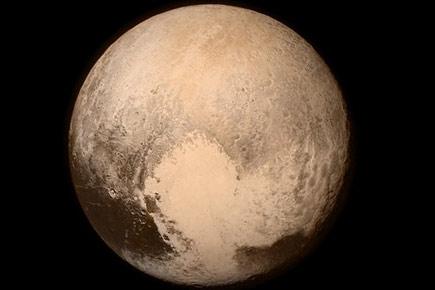NASA's New Horizons spacecraft during it's historic flyby past Pluto has settled a decades-long debate about the size of planet, discovering that the dwarf planet is 2,370 kilometres in diameter, larger than many prior estimates

Washington: NASA's New Horizons mission has settled a decades-long debate about the size of Pluto, discovering that the dwarf planet is 2,370 kilometres in diameter, larger than many prior estimates.
The size was determined from images acquired with the Long Range Reconnaissance Imager (LORRI) aboard New Horizons spacecraft.
ADVERTISEMENT
The result confirms what was already suspected: Pluto is larger than all other known solar system objects beyond the orbit of Neptune.
"The size of Pluto has been debated since its discovery in 1930. We are excited to finally lay this question to rest," said mission scientist Bill McKinnon, Washington University, St Louis.
Pluto's newly estimated size means that its density is slightly lower than previously thought, and the fraction of ice in its interior is slightly higher.
Also, the lowest layer of Pluto's atmosphere, called the troposphere, is shallower than previously believed.
Measuring Pluto's size has been a decades-long challenge due to complicating factors from its atmosphere. Its largest moon Charon lacks a substantial atmosphere, and its diameter was easier to determine using ground-based telescopes.
New Horizons observations of Charon confirm previous estimates of 1,208 km across.
 This photo obtained on July 14, 2015 from NASA shows New Horizons' look at Pluto's Charon-facing hemisphere on July 11, 2015 revealing intriguing geologic details that are of keen interest to mission scientists. An unmanned NASA spacecraft whizzed by Pluto on Tuesday, making its closest approach in the climax of a decade-long journey to explore the dwarf planet for the first time, the US space agency said. Pic/AFP
This photo obtained on July 14, 2015 from NASA shows New Horizons' look at Pluto's Charon-facing hemisphere on July 11, 2015 revealing intriguing geologic details that are of keen interest to mission scientists. An unmanned NASA spacecraft whizzed by Pluto on Tuesday, making its closest approach in the climax of a decade-long journey to explore the dwarf planet for the first time, the US space agency said. Pic/AFP
LORRI has also zoomed in on two of Pluto's smaller moons, Nix and Hydra.
"We knew from the time we designed our flyby that we would only be able to study the small moons in detail for just a few days before closest approach," said New Horizons Principal Investigator Alan Stern of the Southwest Research Institute, Boulder, Colorado.
"Now, deep inside Pluto's sphere of influence, that time has come," Stern said.
Nix and Hydra were discovered using the Hubble Space Telescope in 2005. Even to Hubble, they appeared as points of light, and that's how they looked to New Horizons until the final week of its approach to Pluto.
Now, the latest LORRI images show the two diminutive satellites not as pinpoints, but as moons seen well enough to measure their sizes.
Nix is estimated to be about 35 kilometres across, while Hydra is roughly 45 kilometres across. These sizes lead mission scientists to conclude that their surfaces are quite bright, possibly due to the presence of ice.
However, Pluto's two smallest moons, Kerberos and Styx are smaller and fainter than Nix and Hydra, so they are harder to measure.
Mission scientists should be able to determine their sizes with observations New Horizons will make during the flyby today and will transmit to Earth at a later date.
After nine years and three billion miles travelled, the New Horizons probe will pass within just 12,500 kilometres of Pluto's surface.
Scientists see Pluto in close-up for first time
Scientists have captured planet Pluto's first-time ever close up view.
After nine-and-a-half years and just over five billion kilometers, the much anticipated and incredibly long awaited closest encounter of the planet will be made by NASA's spacecraft New Horizons Pluto at exactly 9:49:57 pm (AEST) today.
CSIRO's Canberra Deep Space Communication Complex (CDSCC) will be the first place on Earth to receive the closest encounter images as it's sent through from the space probe.
The world would finally see Pluto's appearance up close, as the spacecraft flies 12,500 km above the surface, taking detailed measurements and images of the dwarf planet and its moons.
Head of CSIRO's Astronomy and Space Science, Dr. Lewis Ball, said the New Horizons mission has been one of the great explorations of their time. Reaching this part of the solar system had been a space science priority for years, because it held building blocks of our solar system that had been stored in a deep freeze for billions of years.
While Pluto was downgraded from a planet to a dwarf planet in 2006, it is thought to contain important clues about the origins of the solar system. These icy bodies were thought to be relics of the materials that had originally built up to become the larger planets. This would be the first time that scientists could study the process as it happened.
Dr. Ball said that CDSCC has been involved in many of space exploration¿s greatest moments and capturing Pluto would be the capstone of the amazing space adventure. They would be rewriting textbooks and science that would be taught in the classrooms of tomorrow.
 Subscribe today by clicking the link and stay updated with the latest news!" Click here!
Subscribe today by clicking the link and stay updated with the latest news!" Click here!







